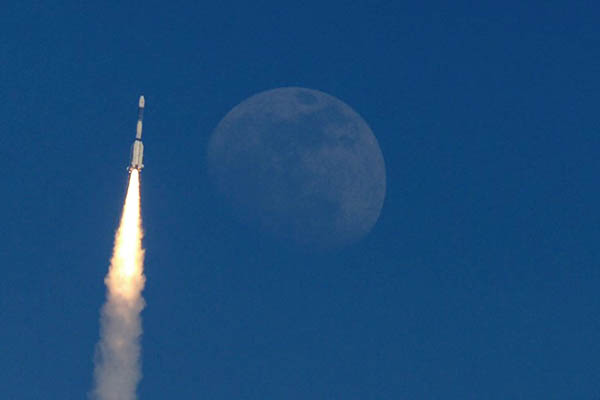
The Indian military communication satellite GSAT-7A is pictured next to the moon as it is launched into orbit. Arun Sankar—AFP
New Delhi approves $1.4 billion for its first manned space mission, expected in 2022
India will send a three-member team into orbit for up to a week when it launches its first manned space mission expected in 2022, the government announced on Friday.
Indian ministers approved $1.4 billion to provide technology and infrastructure for the program, according to a government statement. The sum would make India’s one of the cheapest manned space programs, stepping up its space rivalry with China. But the statement said India also hopes to take part in “global” space projects.
India will become the fourth nation after Russia, the United States and China to send a manned mission into space. Ministers approved financing to launch an Indian-developed craft into a “low earth orbit” for a duration ranging from one orbital period to a maximum of seven days, the statement said.
Prime Minister Narendra Modi announced in August that India would launch a manned space flight by 2022 with at least one astronaut. The cabinet had not approved the project however.
There will be two unmanned and one manned flights to launch the Gaganyaan (Sky-Vehicle) Program, the statement said. Without giving a date for the blast off, the government said the manned flight would be “within 40 months” of Friday’s meeting.
Modi has hailed the national space program as a prestige project.
The government has stated that space flights will boost the economy, generate jobs and enhance capabilities in areas such as medicine, agriculture and fighting pollution. A successful manned mission would allow India to become a “collaborating partner in future global space exploration initiatives with long term national benefits,” said the statement.
The country has invested heavily in its space program in the past decade. The Indian Space Research Organization announced in July that it planned to send an unmanned mission to the moon in 2019. India launched an orbiter to Mars in 2013, which is still operational and last year launched a record 104 satellites in one blast-off.
New Delhi is competing with other international players for a greater share of the satellite market, and hopes its low-cost space program will give it an edge.
China put its first humans into space in 2003 but its Shenzhou program cost more than $2.3 billion. Experts say the United States spent the equivalent of about $110 billion at current values on preparatory flights and the mission to put the first man on the moon in 1969.
